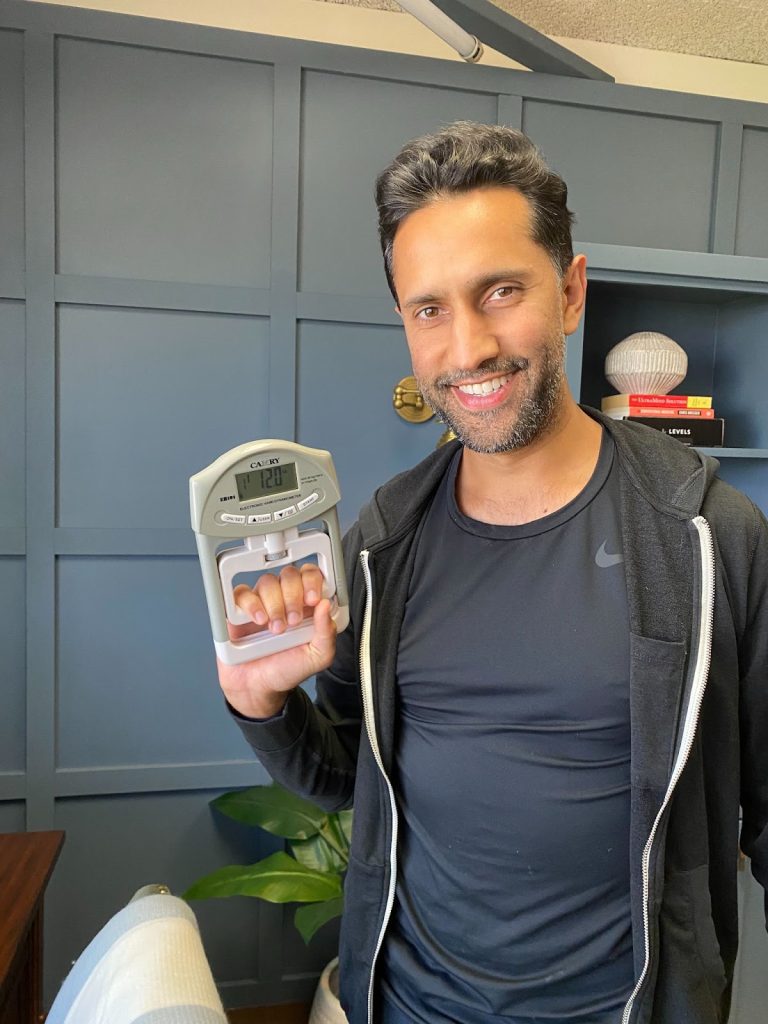What do you think is the number-one predictor of longevity?
Is it eating a healthy diet? Noooo…
Is it exercising every day and getting plenty of rest? Nope!
What about finding positive outlets to manage our stress? Nah!
Sure, all of these things are 100 percent essential for optimal health, no doubt! BUT, there’s another metric that’s actually a better predictor of longevity.
Do you want to know what it is?
It’s your grip strength!
But, despite what it sounds like, grip strength isn’t just about the strength of your grip. There’s more to it than that!
Your grip strength is an indicator of your body’s total muscle mass and strength—two key markers of longevity and aging that muscle-centric physician Dr. Gabrielle Lyon talked about in our interview together (that went viral, by the way!).
Today we’re discussing why you want a strong grip, how it can help protect against disease, and what you can do to start optimizing your grip strength today.
But first, I want to give a shout-out to this week’s Try This sponsor, Pique Life.

I’ve been a believer in the power of tea as medicine for years. Polyphenol-rich teas have been studied for their amazing benefits including improved digestion, cardiovascular health, immunity, and even their ability to ward off cancer.
When it comes to tea, you want the best quality. And I can honestly say that I’ve been blown away by my experience with Pique Life.
Pique Life triple toxin screens for heavy metals, pesticides, and mold—super common contaminants found in teas today. My favorite part about Pique is that their tea crystals require no prep or brewing, so I can bring a sachet with me and enjoy a delicious cup of tea wherever I go.
Lately, I’ve been loving Pique’s Fermented Pu’er Tea Crystals made from wild-harvested ancient trees in a pristine region of the Himalayas. Their green and black teas naturally contain probiotics and are more concentrated in polyphenols than any other tea in the world. And at less than $2.00 per cup, you really can’t get that kind of quality anywhere else.
Right now, Pique is offering my Try This community up to 20% off + free shipping on their Pu’er Bundles—these teas have never been discounted before, so you don’t want to miss out!
Click here to get 20% off Pique Life’s Pu’er Bundle.

Alright, let’s jump in!
Why Do We Want a Strong Grip?
Well, we all know how this scene ended in The Lion King:

Although in fairness to Mufasa (may he rest in peace), he probably would have pulled himself up if it wasn’t for that damn Scar clawing his hands.
Not that we necessarily need a strong grip to save ourselves from a stampede of antelopes, but we do need a strong grip to have a better chance of catching ourselves if we lose our balance.
Plain and simple, the stronger our grip, the better chance we have at protecting ourselves from a bad fall.
This is especially true as we age, because a bad fall increases the risk of losing our mobility—and the downward spiral that tends to happen thereafter.
Now, I want to be super clear that strengthening your grip isn’t as simple as using one of those handheld grippers; there’s a lot more to it than that!
A weak grip is a sign that the entire body is lacking muscle mass, which is a big problem because muscle serves as a cushion for our bones.
Studies show that people with a weak grip are more likely to have or develop sarcopenia and osteoporosis, which, not surprisingly, also puts them at an increased risk for fractures.
Grip strength is also strongly related to a person’s biological age, because it can predict overall health by their ability to participate in daily life activities, such as walking, standing, and climbing stairs (1)(2).
And it’s not just overall strength, risk of fracture, and quality of life that our grip is a sign of; it’s also an excellent predictor of metabolic health, physical strength, and stamina.
Grip Strength and Metabolic Health
In many studies, people with below-average grip strength are more likely to have high fasting blood sugar, high HbA1c, and metabolic dysfunction (3).
One study even found that grip strength was a better predictor of cardiovascular disease than blood pressure (4). Similar studies have found a link between grip strength and the risk for type 2 diabetes, disability, hospitalization, and all-cause mortality (5).
Yikes, that’s a long list—and a frightening one at that!—but how exactly is grip strength related to poor metabolic health? My friend Dr. Gabrielle Lyon says it is because we are overweight and under-muscled, with our high-carb, low-protein, standard American diet and sedentary lifestyle primarily to blame.
Why Muscle Mass Is So Important for Chronic Disease Prevention
Our muscle is the largest organ in our body and the biggest reservoir we have for storing glucose. Any extra glucose left over from a meal that our body doesn’t use is stored in our muscles as backup fuel to power muscle movement.
Storing excess glucose in our muscles prevents it from being converted into fat. This is why having lean muscle mass is so helpful for balanced blood sugar and insulin sensitivity. The only requirement is to use up the glucose that’s stored by working out our muscles. That way, the next time we eat something rich in carbs or sugar, there’s room for it to be stored again.
For those reasons and more, muscle mass is critical for metabolic health, strengthening and cushioning our bones from a fall, and protecting against premature aging and death. Strengthening our grip and measuring our grip strength is one of the best ways to know where we stand, which is what today’s protocol is about!
Try This:
- Incorporate resistance training into your weekly exercise protocol. Experts in the longevity field typically agree that 150 minutes of exercise per week is the minimal viable dose for optimal health. It is also advised that 30–60 minutes of this be dedicated to resistance training. If you’re new to strength training, check out this beginner’s guide to get started.
- Get enough high-quality protein: A huge part of building and maintaining muscle mass is including enough protein in your diet. The topic of protein has historically been hotly debated. But more and more experts, regardless of dietary approach, are recommending that individuals shoot to eat one gram of protein per pound of body weight per day. If you are looking for a deeper breakdown on this, check out this article by Dr. Peter Attia and this free e-book by Simon Hill, who follows a plant-based diet.
- Take an omega-3 supplement. A high-dose omega-3 supplement (about two grams per day) can have a synergistic effect when combined with a muscle-strengthening protocol. In a meta-analysis published in the journal Nutrients, elderly adults who supplemented with omega-3 in addition to resistance training had improved walking speed, muscle mass, and muscle strength (6).
- Measure your grip strength at home. You can order an electric handheld dynamometer to measure your own grip strength at home. Here’s one I tested out on Amazon. I like it because it will tell you whether your measurement is strong, weak, or normal based on age and gender. I tested my grip strength using the dynamometer above, and the results were super interesting. Here are my results and some notes from my experience:
Right hand: 106.2 (Normal)

Left hand: 96.6 (Normal)

Even though I’m in the normal range and I’m pretty active at home, I’ll admit that up until recently, I’ve been more focused more on HIIT workouts a few times a week than strength training.
But after my conversation with Dr. Gabrielle Lyon and following the work of Andrew Huberman, Peter Attia, and other prominent leaders in the health space, I’m excited to retest in a few months after going all-in on this new strength-training regime as well as increasing my protein intake. My goal is to hit “strong” before the end of the year. I’ll report back!

Final Thoughts
Isn’t it awesome how one metric, like grip strength, can tell us so much about the status of our overall health and longevity? There are really not many other markers (if any!) that you can test that don’t require asking your doctor to order a lab test.
What did you think of this newsletter? If you found it interesting, forward it to a friend!
Here’s to a stronger you,
Dhru Purohit